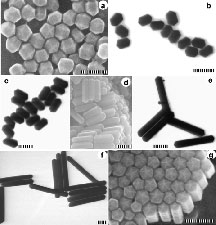| New studies have improved the understanding of the role of seeds in solution-phase growth of nanocrystals with complex structures and materials compositions. |
Reviewed by Jeff Morse, Ph.D., National Nanomanufacturing Network
- Pietrobon, B., McEachran, M., Kitaev, V. 2009. Synthesis of Size-controlled Faceted Pentagonal Silver Nanorods with Tunable Plasmonic Properties and Self Assembly of these Nanorods. ACS Nano 3(1):21-26. DOI: 10.1021/nn800591y
- Lim, B., Wang, J., Camargo, P., Jiang, M., Kim, M., Xia, Y. 2008. Facile Synthesis of Bimetallic Nanoplates Consisting of Pd Cores and Pt Shells through Seeded Epitaxial Growth 8(8):2535-2540. DOI: 10.1021/nl8016434
- Park, K., Vaia, R.A. 2008. Synthesis of Complex Au/Ag Nanorods by Controlled Overgrowth. Adv Mater 20:3882-3886. DOI: 10.1002/adma.200800613
Research on the properties of nanocrystal materials has resulted in the discovery and analysis of size related effects for dimensionally confined structures. Seeded growth has emerged as a viable means for controlling the size, shape, morphology, and composition of nanocrystal materials and has applications in areas including catalysis, information storage, photonics, electronics, plasmonics, and sensing. A new understanding of process chemistries that incorporates solution-phase, bottom-up methodologies with controlled non-conformal deposition has been developed to generate seed materials with specific structures and properties. Furthermore, the ability to achieve very narrow size distributions through a one step or quasi-continuous synthesis procedure makes seeded growth an ideal candidate for scaled nanomanufacturing as specific nanocrystal materials and structures are integrated for potential device applications.

Another recent article by Lim, et. al. reports the seeded growth of bimetallic nanoplates having Pd cores and Pt shells. Such heteroepitaxial techniques now enable the creation of materials and structures that previously were not possible. In the case of Pt nanocrystals, regrowth in solution-phase processes is inhibited by the high strain energy associated with Pt. A third article by Park and Vaia demonstrates the synthesis of Au/Ag nanorods by controlled overgrowth. By varying the ratios of a mixed regrowth solution, containing surfactant, acid, and AgNO3 the authors could preferentially deposit Ag on the top of Au nanorods, maintaining non-conformal deposition. Therefore, by controlling the passivation and surface chemistry of the Au nanorod sidewalls, directed growth of bimetallic nanostructures could be achieved. Together, these reports improve the understanding of the role of seeds in solution-phase growth of nanocrystals with complex structures and materials compositions.
The possibility of utilizing this technique to synthesize complex, multicomponent nanocrystals is beginning to emerge. Adding multifunctional materials to metallic structures, such as metal oxides and metal chalcogenides, nanocrystals now create the potential to integrate semiconductor-metallic structures in highly organized configurations. Further establishing such a directed growth synthesis of multifunctional material structures in versatile bottom-up processes has broad implications for future energy, electronic, and sensor applications where novel hybrid assemblies can be realized as highly integrated components.
Image reproduced with permission from Pietrobon, B., McEachran, M., Kitaev, V. 2009. Synthesis of Size-controlled Faceted Pentagonal Silver Nanorods with Tunable Plasmonic Properties and Self Assembly of these Nanorods. ACS Nano 3(1):21-26. Copyright 2009 American Chemical Society.
This work is licensed under a Creative Commons Attribution-NonCommercial-NoDerivs 3.0 Unported.
